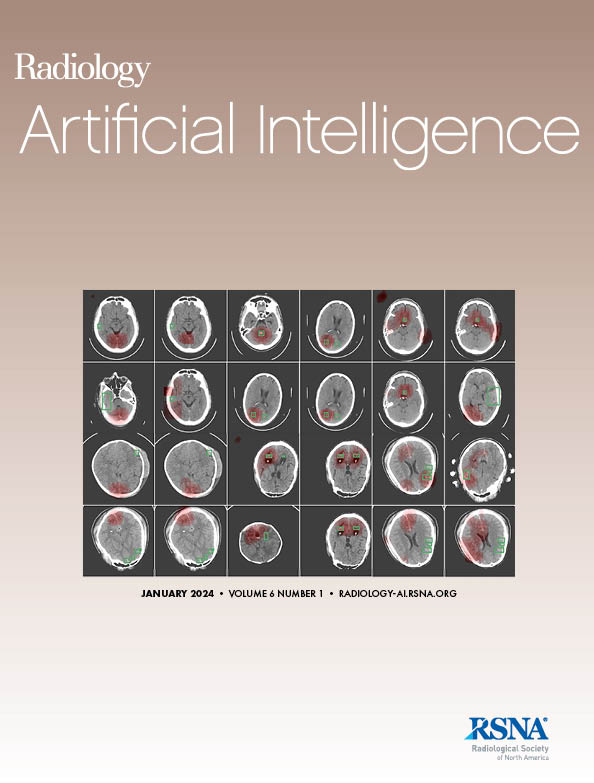Chaowei Wu, Lixia Wang, Nan Wang, Stephen Shiao, Tai Dou, Yin-Chen Hsu, Anthony G Christodoulou, Yibin Xie, Debiao Li
下载PDF
{"title":"基于深度学习的DCE MRI药代动力学量化预测乳腺癌早期新辅助化疗反应","authors":"Chaowei Wu, Lixia Wang, Nan Wang, Stephen Shiao, Tai Dou, Yin-Chen Hsu, Anthony G Christodoulou, Yibin Xie, Debiao Li","doi":"10.1148/ryai.240769","DOIUrl":null,"url":null,"abstract":"<p><p>Purpose To improve the generalizability of pathologic complete response prediction following neoadjuvant chemotherapy using deep learning-based retrospective pharmacokinetic quantification of early treatment dynamic contrast-enhanced MRI. Materials and Methods This multicenter retrospective study included breast MRI data from four publicly available datasets of patients with breast cancer acquired from May 2002 to November 2016. Pharmacokinetic quantification was performed using a previously developed deep learning model for clinical multiphasic dynamic contrast-enhanced MRI datasets. Radiomic analysis was performed on pharmacokinetic quantification maps and conventional enhancement maps. These data, together with clinicopathologic variables and shape-based radiomic analysis, were subsequently applied for pathologic complete response prediction using logistic regression. Prediction performance was evaluated by area under the receiver operating characteristic curve (AUC). Results A total of 1073 female patients with breast cancer were included. The proposed method showed improved consistency and generalizability compared with the reference method, achieving higher AUC values across external datasets (0.82 [95% CI: 0.72, 0.91], 0.75 [95% CI: 0.71, 0.79], and 0.77 [95% CI: 0.66, 0.86] for datasets A2, B, and C, respectively). For dataset A2 (from the same study as the training dataset), there was no significant difference in performance between the proposed method and reference method (<i>P</i> = .80). Notably, on the combined external datasets, the proposed method significantly outperformed the reference method (AUC, 0.75 [95% CI: 0.72, 0.79] vs AUC, 0.71 [95% CI: 0.68, 0.76]; <i>P</i> = .003). Conclusion This work offers an approach to improve the generalizability and predictive accuracy of pathologic complete response for breast cancer across diverse datasets, achieving higher and more consistent AUC scores than existing methods. <b>Keywords:</b> Tumor Response, Breast, Prognosis, Dynamic Contrast-enhanced MRI <i>Supplemental material is available for this article.</i> © RSNA, 2025 See also commentary by Schnitzler in this issue.</p>","PeriodicalId":29787,"journal":{"name":"Radiology-Artificial Intelligence","volume":" ","pages":"e240769"},"PeriodicalIF":13.2000,"publicationDate":"2025-09-01","publicationTypes":"Journal Article","fieldsOfStudy":null,"isOpenAccess":false,"openAccessPdf":"https://www.ncbi.nlm.nih.gov/pmc/articles/PMC12464716/pdf/","citationCount":"0","resultStr":"{\"title\":\"Prediction of Early Neoadjuvant Chemotherapy Response of Breast Cancer through Deep Learning-based Pharmacokinetic Quantification of DCE MRI.\",\"authors\":\"Chaowei Wu, Lixia Wang, Nan Wang, Stephen Shiao, Tai Dou, Yin-Chen Hsu, Anthony G Christodoulou, Yibin Xie, Debiao Li\",\"doi\":\"10.1148/ryai.240769\",\"DOIUrl\":null,\"url\":null,\"abstract\":\"<p><p>Purpose To improve the generalizability of pathologic complete response prediction following neoadjuvant chemotherapy using deep learning-based retrospective pharmacokinetic quantification of early treatment dynamic contrast-enhanced MRI. Materials and Methods This multicenter retrospective study included breast MRI data from four publicly available datasets of patients with breast cancer acquired from May 2002 to November 2016. Pharmacokinetic quantification was performed using a previously developed deep learning model for clinical multiphasic dynamic contrast-enhanced MRI datasets. Radiomic analysis was performed on pharmacokinetic quantification maps and conventional enhancement maps. These data, together with clinicopathologic variables and shape-based radiomic analysis, were subsequently applied for pathologic complete response prediction using logistic regression. Prediction performance was evaluated by area under the receiver operating characteristic curve (AUC). Results A total of 1073 female patients with breast cancer were included. The proposed method showed improved consistency and generalizability compared with the reference method, achieving higher AUC values across external datasets (0.82 [95% CI: 0.72, 0.91], 0.75 [95% CI: 0.71, 0.79], and 0.77 [95% CI: 0.66, 0.86] for datasets A2, B, and C, respectively). For dataset A2 (from the same study as the training dataset), there was no significant difference in performance between the proposed method and reference method (<i>P</i> = .80). Notably, on the combined external datasets, the proposed method significantly outperformed the reference method (AUC, 0.75 [95% CI: 0.72, 0.79] vs AUC, 0.71 [95% CI: 0.68, 0.76]; <i>P</i> = .003). Conclusion This work offers an approach to improve the generalizability and predictive accuracy of pathologic complete response for breast cancer across diverse datasets, achieving higher and more consistent AUC scores than existing methods. <b>Keywords:</b> Tumor Response, Breast, Prognosis, Dynamic Contrast-enhanced MRI <i>Supplemental material is available for this article.</i> © RSNA, 2025 See also commentary by Schnitzler in this issue.</p>\",\"PeriodicalId\":29787,\"journal\":{\"name\":\"Radiology-Artificial Intelligence\",\"volume\":\" \",\"pages\":\"e240769\"},\"PeriodicalIF\":13.2000,\"publicationDate\":\"2025-09-01\",\"publicationTypes\":\"Journal Article\",\"fieldsOfStudy\":null,\"isOpenAccess\":false,\"openAccessPdf\":\"https://www.ncbi.nlm.nih.gov/pmc/articles/PMC12464716/pdf/\",\"citationCount\":\"0\",\"resultStr\":null,\"platform\":\"Semanticscholar\",\"paperid\":null,\"PeriodicalName\":\"Radiology-Artificial Intelligence\",\"FirstCategoryId\":\"1085\",\"ListUrlMain\":\"https://doi.org/10.1148/ryai.240769\",\"RegionNum\":0,\"RegionCategory\":null,\"ArticlePicture\":[],\"TitleCN\":null,\"AbstractTextCN\":null,\"PMCID\":null,\"EPubDate\":\"\",\"PubModel\":\"\",\"JCR\":\"Q1\",\"JCRName\":\"COMPUTER SCIENCE, ARTIFICIAL INTELLIGENCE\",\"Score\":null,\"Total\":0}","platform":"Semanticscholar","paperid":null,"PeriodicalName":"Radiology-Artificial Intelligence","FirstCategoryId":"1085","ListUrlMain":"https://doi.org/10.1148/ryai.240769","RegionNum":0,"RegionCategory":null,"ArticlePicture":[],"TitleCN":null,"AbstractTextCN":null,"PMCID":null,"EPubDate":"","PubModel":"","JCR":"Q1","JCRName":"COMPUTER SCIENCE, ARTIFICIAL INTELLIGENCE","Score":null,"Total":0}
引用次数: 0
引用
批量引用

 求助内容:
求助内容: 应助结果提醒方式:
应助结果提醒方式:


